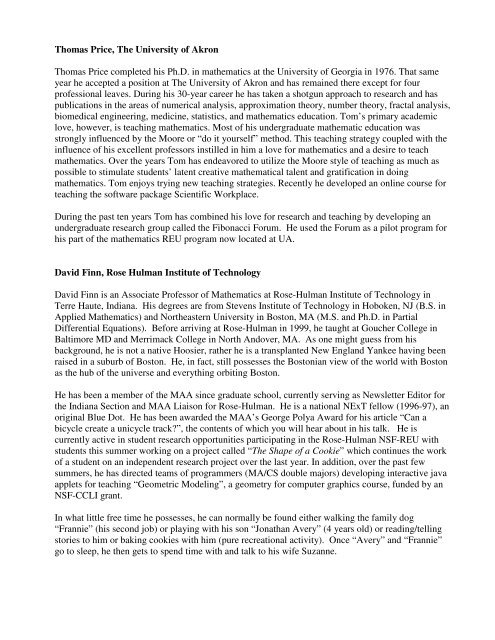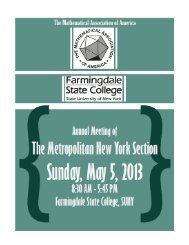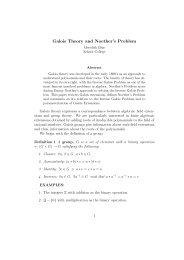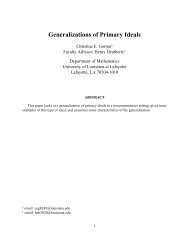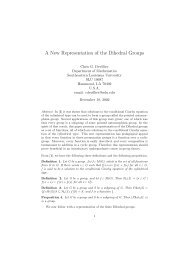Program - MAA Sections - Mathematical Association of America
Program - MAA Sections - Mathematical Association of America
Program - MAA Sections - Mathematical Association of America
Create successful ePaper yourself
Turn your PDF publications into a flip-book with our unique Google optimized e-Paper software.
Thomas Price, The University <strong>of</strong> Akron<br />
Thomas Price completed his Ph.D. in mathematics at the University <strong>of</strong> Georgia in 1976. That same<br />
year he accepted a position at The University <strong>of</strong> Akron and has remained there except for four<br />
pr<strong>of</strong>essional leaves. During his 30-year career he has taken a shotgun approach to research and has<br />
publications in the areas <strong>of</strong> numerical analysis, approximation theory, number theory, fractal analysis,<br />
biomedical engineering, medicine, statistics, and mathematics education. Tom’s primary academic<br />
love, however, is teaching mathematics. Most <strong>of</strong> his undergraduate mathematic education was<br />
strongly influenced by the Moore or “do it yourself” method. This teaching strategy coupled with the<br />
influence <strong>of</strong> his excellent pr<strong>of</strong>essors instilled in him a love for mathematics and a desire to teach<br />
mathematics. Over the years Tom has endeavored to utilize the Moore style <strong>of</strong> teaching as much as<br />
possible to stimulate students’ latent creative mathematical talent and gratification in doing<br />
mathematics. Tom enjoys trying new teaching strategies. Recently he developed an online course for<br />
teaching the s<strong>of</strong>tware package Scientific Workplace.<br />
During the past ten years Tom has combined his love for research and teaching by developing an<br />
undergraduate research group called the Fibonacci Forum. He used the Forum as a pilot program for<br />
his part <strong>of</strong> the mathematics REU program now located at UA.<br />
David Finn, Rose Hulman Institute <strong>of</strong> Technology<br />
David Finn is an Associate Pr<strong>of</strong>essor <strong>of</strong> Mathematics at Rose-Hulman Institute <strong>of</strong> Technology in<br />
Terre Haute, Indiana. His degrees are from Stevens Institute <strong>of</strong> Technology in Hoboken, NJ (B.S. in<br />
Applied Mathematics) and Northeastern University in Boston, MA (M.S. and Ph.D. in Partial<br />
Differential Equations). Before arriving at Rose-Hulman in 1999, he taught at Goucher College in<br />
Baltimore MD and Merrimack College in North Andover, MA. As one might guess from his<br />
background, he is not a native Hoosier, rather he is a transplanted New England Yankee having been<br />
raised in a suburb <strong>of</strong> Boston. He, in fact, still possesses the Bostonian view <strong>of</strong> the world with Boston<br />
as the hub <strong>of</strong> the universe and everything orbiting Boston.<br />
He has been a member <strong>of</strong> the <strong>MAA</strong> since graduate school, currently serving as Newsletter Editor for<br />
the Indiana Section and <strong>MAA</strong> Liaison for Rose-Hulman. He is a national NExT fellow (1996-97), an<br />
original Blue Dot. He has been awarded the <strong>MAA</strong>’s George Polya Award for his article “Can a<br />
bicycle create a unicycle track?”, the contents <strong>of</strong> which you will hear about in his talk. He is<br />
currently active in student research opportunities participating in the Rose-Hulman NSF-REU with<br />
students this summer working on a project called “The Shape <strong>of</strong> a Cookie” which continues the work<br />
<strong>of</strong> a student on an independent research project over the last year. In addition, over the past few<br />
summers, he has directed teams <strong>of</strong> programmers (MA/CS double majors) developing interactive java<br />
applets for teaching “Geometric Modeling”, a geometry for computer graphics course, funded by an<br />
NSF-CCLI grant.<br />
In what little free time he possesses, he can normally be found either walking the family dog<br />
“Frannie” (his second job) or playing with his son “Jonathan Avery” (4 years old) or reading/telling<br />
stories to him or baking cookies with him (pure recreational activity). Once “Avery” and “Frannie”<br />
go to sleep, he then gets to spend time with and talk to his wife Suzanne.


